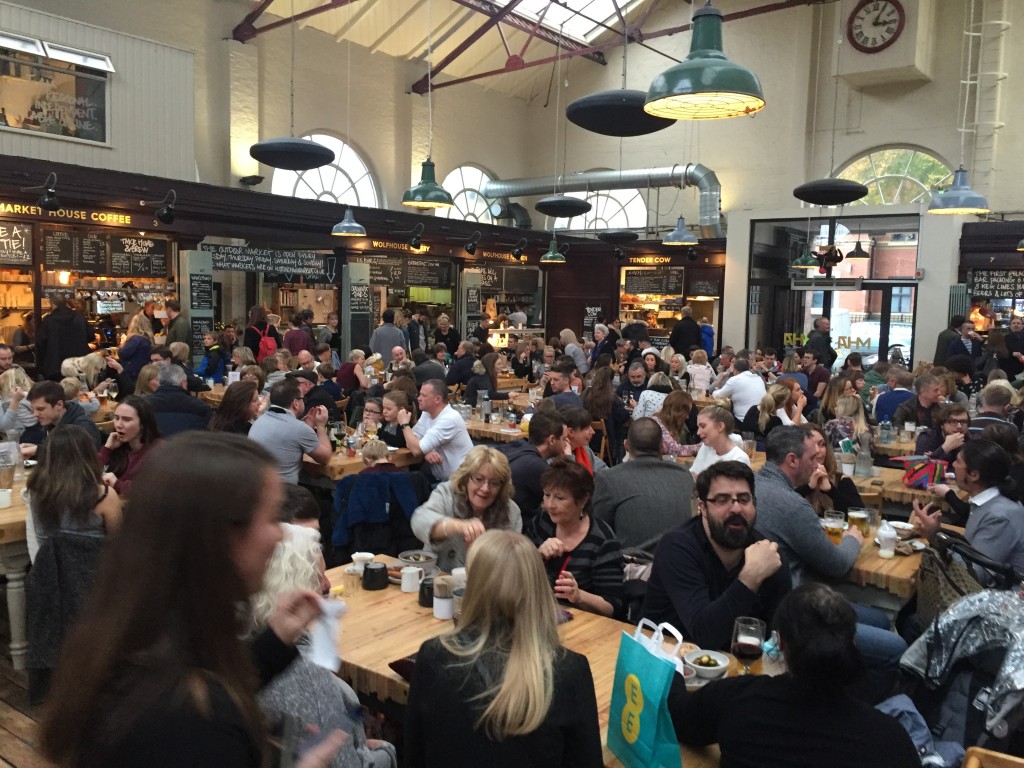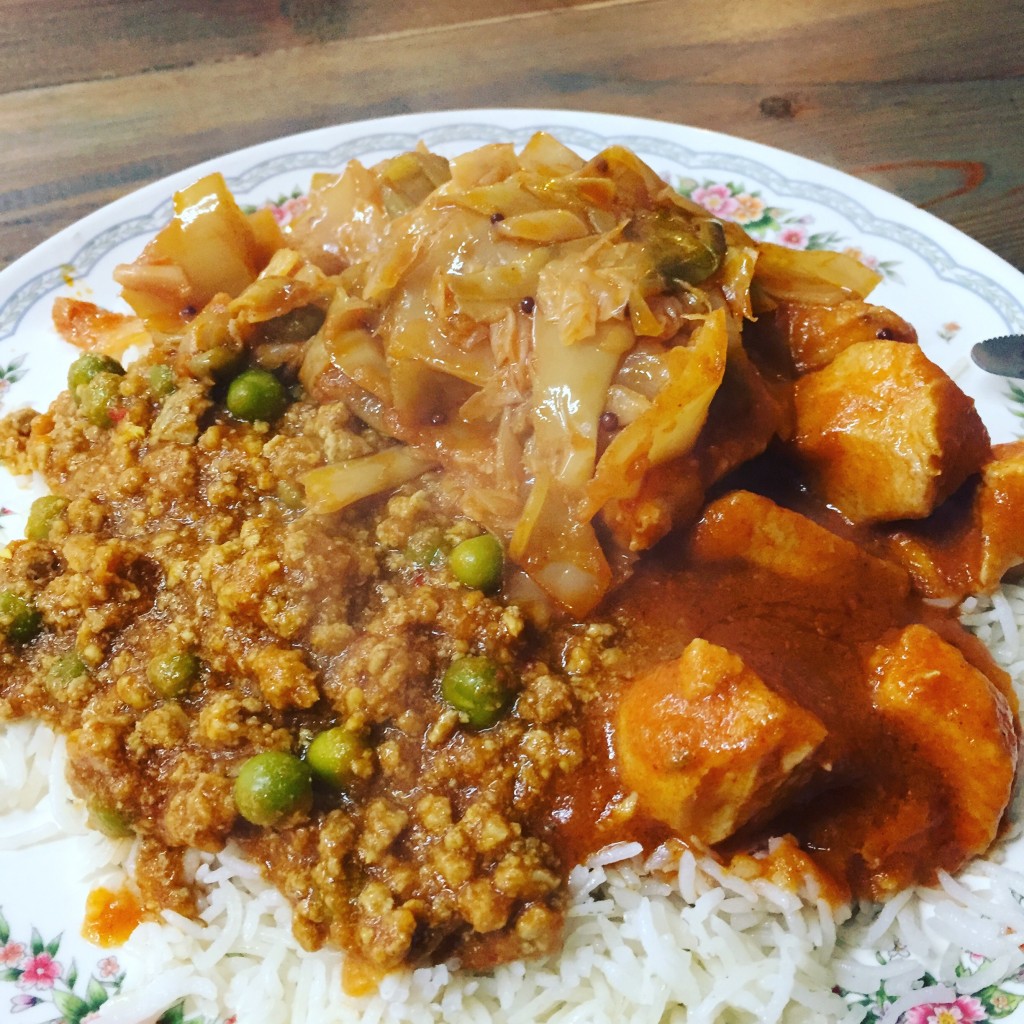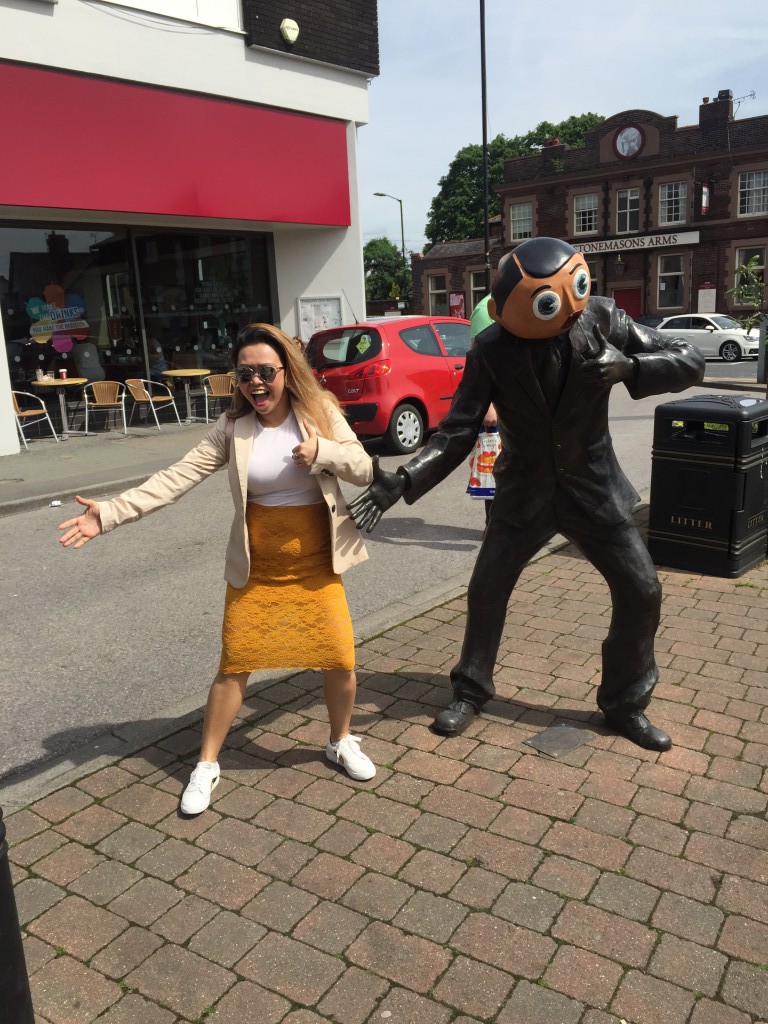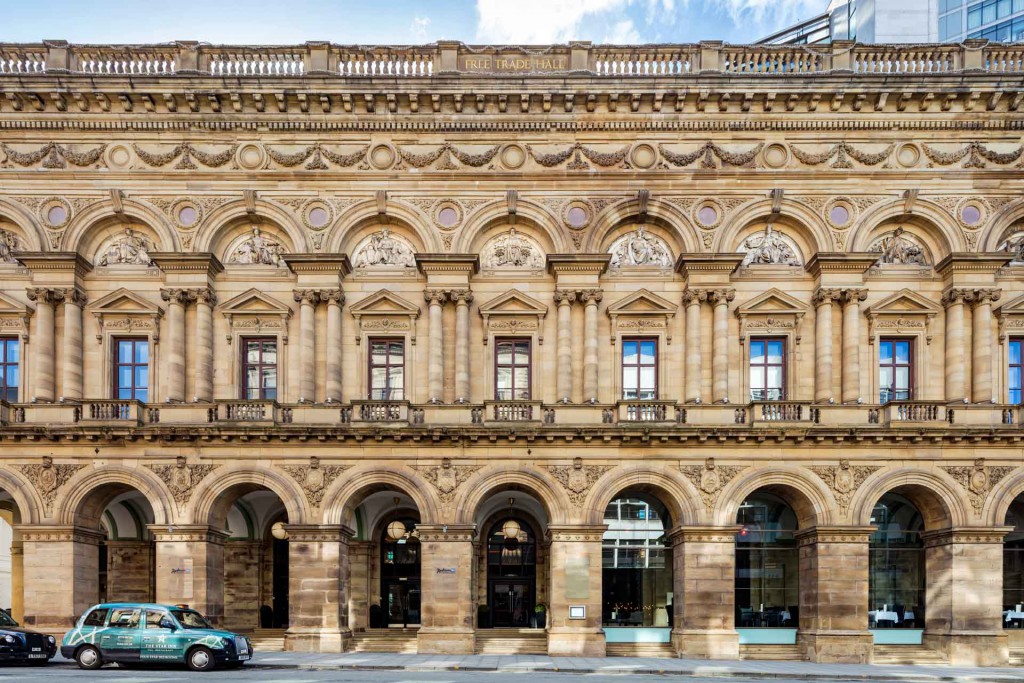Altrincham Market House: Things to Do in Manchester
A Community Revitalised…
The revival of the Altrincham Market is nothing short of remarkable. From 1290 (yes, 1290!) the market had been at the centre of community life in Altrincham. Throughout the centuries, the market would have been where townsfolk gathered to buy goods, make a living, and spend time in the company of their neighbours.
And yet, the second half of the 20th century brought a period of stagnation. With the fortunes of the town on the downturn and the population size decreasing year over year, the historic market was being run by the council with little love or care. In fact, around a decade ago, Altrincham was voted as having the worse high street in Britain.
So, what has changed?
Well, Nick Johnson came onto the scene. Nick was a property developer and saw something in Altrincham that others failed to spot. In 2013, he won the contract to run the market and quickly set about changing the face of it and in turn Altrincham.
Listen to Nick’s fascinating account of how he came to the project in the excellent documentary below.
Nick gave the Victorian building a makeover. Cleaning it from top to bottom and restoring some features that had been neglected. He then got to work contacting some of the area’s best, local food vendors.
Nick did the same in Manchester city centre with the Mackie Mayor food hall, the big sister of Altrincham Market House. We previously wrote about Mackie Mayor here.
Food and Drink at Altrincham Market House
Since it reopened in 2014, locals and visitors have filled the food hall week after week, and it should come as no surprise – the food on offer is second to none!
Market House is home to 10 indie food stalls, including Honest Crust, Wolfhouse Kitchen, Tender Cow, Jack in the Box, Reserve Wines, Great North Pie Co., Sam Joseph, and Market House Coffee.
Jack in the Box is an award-winning producer of real ale and cider that operate across the Mackie Mayor and Altrincham Market Houe locations. Serving tasty beers from the Blackjack Brewing Co. and other guest breweries, Jack in the Box is the perfect place to catch up with a friend while enjoying a locally-produced brew.
Meanwhile, Honest Crust serves up magnificent sourdough pizzas cooked in a tiled oven imported from Italy. While there is now a wealth of options for great pizza in Manchester, Honest Crust has proved themselves to be stalwarts of the scene. If you fancy eating a perfectly cooked pizza in an atmospheric setting, look no further than Honest Crust at Altrincham Market House.
Looking to eat some traditional northern fare while in the Manchester area? You can’t go wrong with the Great North Pie Co. at the Alty. Having started in a residential kitchen, the Great North Pie Co. has bloomed into one of England’s best producers of pies, having amassed several awards and nominations along the way. Cold day out? There’s no better English comfort food than a serving of pie and mash!
Shops and Events at Altrincham Market
A big part of Altrincham market’s success story is in how the market has really brought a fresh buzz to the town. In fact, Altrincham was recently voted as one of the best places to live in the UK and the market has surely played a part in that.
Throughout the week, you can buy food from local food suppliers, including award-winning butchers, greengrocers, bakers, and fishmongers.
Additionally, there are other regular stalls selling clothes, hand-crafted jewellery, furniture, and much else besides.
Each weekend, Altrincham Market has a different theme, providing locals and visitors alike with plenty of variety throughout the year. Themes include craft and design, vintage, and food (similarly, focused themes apply to the days of the week too) – head to Altrincham Market’s Facebook page for the latest events listings.
Getting to Altrincham Market
Located eight miles outside of Manchester, the Altrincham Market is well connected and easily accessible.
The fastest and most convenient way to get from Manchester city centre to Altrincham is by tram. Altrincham is on the Metrolink’s A and B. The journey from Manchester city centre will take around 30 minutes.
If you prefer to take the bus from Manchester city centre, the 16, 41, 108, 263, and 264 services all head to Altrincham. The journey will take you around an hour.
Trains are also fairly regular, with departures taking place each hour from Manchester Piccadilly on the Mid Cheshire line.
Finally, if you are driving, the journey should take no more than 30 minutes.
When is Altrincham Market Open
The Altrincham Market House (Food Hall) is open Tuesday – Saturday 9 am – 10 pm, and Sunday 9 am – 6 pm.
Alty Market (Outdoor Market Section) is open from 8 am to 4 pm on Tuesday, Friday, and Saturday. 8 am to 3 pm on Thursday. 10 am to 4 pm on Sunday.
This brings an end to our short guide on Altrincham Market House. If you have any questions or queries, don’t hesitate to get in touch!

A Manchester food institution. This and That cafe.
One of our favourite places to visit in Manchester’s Northern Quarter is the This and That cafe. This and That has been a Manchester institution since it opened in 1984. Not only does it serve some of the city’s best curry dishes. It also epitomises the entrepreneur spirit of Manchester. Telling the story of South Asian immigrants introducing their flavours to us Mancunians.
A hidden gem in the Northern Quarter
This and That is hidden. It lies up a dark and dingy backstreet that looks like it’s been derelict for decades. Ironically this street is called soap street. There’s a small sign outside the restaurant that tells you you’re in the right place but apart from that, nothing.
The restaurant opened in 1984 and became famous for serving rice and three. Basically a big helping of pilau rice and 3 different curries
At the time the area was mostly used by the cloth trade which was heavily run by Pakistani immigrants. It made sense to open a restaurant nearby to feed the hungry workers. It didn’t take long for word to get out and soon enough the locals were eager to try the new flavours.
A bit of this and some of that
Indian and Pakistani food wasn’t well known in the 80’s like it is today. Most English customers used to just point at the dishes and say “I’ll have a bit of this, and some of that.” Hence the restaurant is called the This and That cafe.
In 2016 the restaurant received a bit of a makeover. The seating was extended to cope with the lunchtime crowds. Owner Ismail Mallu still works behind the counter dishing out the home made curries everyday.
If you’d like to explore Manchester and find places like This and That, book a food tour with us today. www.manchesterbites.com

Mother of the Sea. How Manchester saved Sushi.
We like talking about Manchester inventions and those Mancunians that have changed the world. Here’s a story of a Manchester food hero that dates back to the early 1900’s. This might just change the way you think about sushi.
In 1901 Kathleen Drew Baker was born in Leigh. She spent her childhood learning about horticulture and gained a scholarship to study at the University of Manchester. She graduated in 1922 and began working as a lecturer at the university.
It was during her time as a lecturer and researcher that she made a crucial discovery. This discovery wasn’t really to effect the food community in Manchester. But it would make a huge difference to life in Japan. Kathleen Drew Baker had discovered a way to farm seaweed. In particular the type of seaweed that is used in sushi.
Nori seaweed cultivation had almost stopped in 1950’s Japan. Due to harsh monsoons and lack of seeds in Nori the Japanese were at a loss for how to farm it. Drew Baker had discovered that seashells could act as a host environment to allow the seaweed to grow.
Mother of the Sea
Once her work was shared to scientists in Japan they immediately got to work farming Nori.
Kathleen Drew Baker never visited Japan and sadly died in 1957. She had no idea how important her findings were to a country she had never even seen.
Today Japan still celebrates Kathleen. On April 14th there is a Drew festival to celebrate her life. She is affectionately known as “The Mother of the Sea.” In Uto Kumamoto there is a statue dedicated to her memory.
So next time you are enjoying sushi you can remember Kathleen. Another food hero of Manchester.
Our Manchester food tours are a great way to explore Manchester. If you’d like to learn more go to www.manchesterbites.com

Bury black pudding. Another Manchester favourite.
If you’re visiting England for the first time you will definitely have to try an English breakfast. A good, old fashioned English fry up is a must try when you’re here. They are not the healthiest of things to eat. But they are perfect for a lazy Saturday morning. Especially when you’re in Manchester, as we claim to be the home of one of the most important ingredients.
Another Manchester food invention
One of the best things about a fried breakfast is black pudding. There’s a market town to the north of Manchester called Bury. It’s here where the Black Pudding was invented in 1810. It was probably invented a lot earlier than that but that’s the longest back we can trace it.
Black pudding is essentially blood sausage. It was common to use every single part of the animal back in the day. Not wanting to waste the blood, butchers created the black pudding. A mixture of pigs blood, cereals and seasonings are squeezed into pork skin. The sausage is then fried and served. It makes a perfect addition to an English breakfast. You can find different examples around the world. Morcilla in Spain and Blutwurst in Germany are both types of black pudding.
Where you can try the original Black Pudding in Manchester.
The market town of Bury is not as affluent as it used to be. It has a famous market there where you can buy black pudding. The Bury Black Pudding company is now the sole surviving business that still makes the pudding in Bury. You can visit their stall at the market. Or you can buy their puddings at major supermarkets around Manchester. If you want a really good breakfast experience we recommend here, https://www.thekoffeepot.co.uk/menus
Since the 1980’s there has been a black pudding throwing competition. The event is held in Ramsbottom near Bury. Contestants have to throw 3 black puddings at a stack of Yorkshire puddings. Whoever knocks the most Yorkshire puddings down wins. If you are in Manchester on the second Saturday of September you should go and check it out.
If you’re looking for a unique tour of Manchester, come and join our food tours. www.manchesterbites.com for more details

The story of Frank Sidebottom.
A Mancunian legend with a papier – mache head. But what is the story of Frank Sidebottom? Here we take a look at Frank’s creator Chris Sievey.
The days before Frank Sidebottom
Chris grew up in Sale which is a suburb to the south of Manchester. He was originally a musician although not a very successful one. He had partnerships with various musicians in the 70’s and 80’s. He started a band called The Freshies. They had some local success with a song with a fantastic name. I’m in love with the girl on the Manchester Virgin Megastore checkout desk. The record got to number 54 in the charts.
The creation of Frank Sidebottom
Frank Sidebottom was created in 1984. Frank was a 35 year old aspiring pop star who still lived with his mum. He lived in the south Manchester village of Timperley. Frank always dressed in a sharp suit but was most recognisable for his huge head. This was originally made from papier – mache and later fibreglass.
During the late 80’s and 90’s Franks popularity in Manchester grew. He would regularly appear on the comedy circuit and even had his own TV show. Frank Sidebottom’s fantastic shed show was first broadcast in 1992. He was a cult figure and would appear on late night music shows along top artists. Sometimes they didn’t know what to make of him.
One Manchester’s most unique statues.
Sadly Chris died in 2010 and with him took the story of Frank Sidebottom. In 2013 a statue of Frank Sidebottom was unveiled right in the heart of Timperley village. As you can see it is a pretty unique statue. Frank was afterall a pretty unique character.
You can visit Timperley and have a photo with the statue by taking the metrolink south. While you’re there make sure to pop into the Quarry Man pub. They do a great ploughman’s lunch.
Join our mailing list and keep up with all things Manchester. If you’d like to explore more of Manchester join our food tour. www.manchesterbites.com for more details.

Manchester’s Free Trade Hall. And that Dylan concert.
We are lucky to have numerous historical buildings in Manchester city centre. One such building that you can visit is Manchester’s Free Trade Hall. Built in 1856 this grade 2 listed building stands on the site of the Peterloo Massacre. Originally the building was used as a meeting place for the local business community.
It had a vital role in the repealing of the corn laws. The corn laws meant that imports of grain, corn and wheat were taxed. This meant that landowners in Britain could charge a higher price for their corn. As a result it became more expensive to eat. Over time many urban centres such as Manchester rose up and rebelled against the law. The Free Trade Hall was Manchester’s epicentre for anti corn law demonstrations.
Fast forward to December 1940. Manchester was under attack from the German Luftwaffe. The Free Trade Hall suffered great damage. Only the frame of the building survived. In the 1950’s the hall was re-built behind the original outer wall.
A centre of Manchester’s music scene.
The Free Trade Hall became home to Manchester’s Halle Orchestra. In fact it continued to be their home right up until 1996. That is when the Bridgewater Hall took over. It wasn’t just classical concerts that the hall held. One of the most famous episodes in the hall’s history came in 1966.
Bob Dylan was touring the UK and at the time was causing quite some controversy. Dylan was using an electric guitar which was seen by many of his fans as distasteful. At a gig in the Free Trade Hall on 16th May, Dylan was heckled and called “Judas” by a concert goer. Many fans started to slow clap and some even walked out. Dylan kept going. He knew what he was doing was changing the face of music at the time. In 1998 Dylan released the recording of the gig. Manchester bands such as The Fall, The Smiths and Joy Division all say they were heavily influenced by this event.
Today the Free Trade Hall is a Radisson Hotel. You can still go in and admire the stunning entrance hall and enjoy a drink at the bar.
If you are interested to know more about Manchester and it’s incredible history, book a tour with us. Our food tours take in some of Manchester’s best local bites as well as a wealth of history and culture. To book a tour go to www.manchesterbites.com

